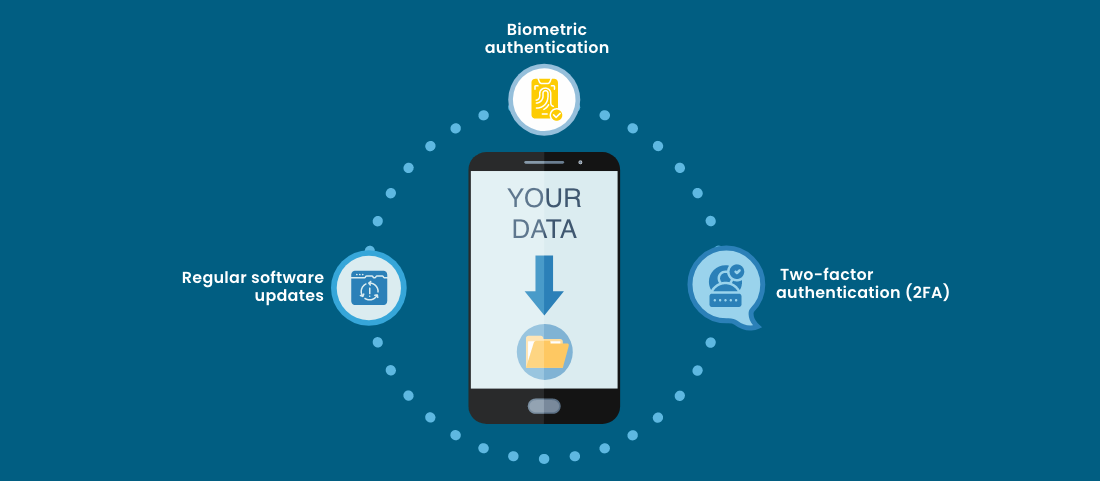A comprehensive guide to protect mobile data through encryption and secure transfer.
Published January 08, 2024. 3 min readIntroduction
With the omnipresence of smartphones and mobile devices, the increased significance of protecting our sensitive data cannot be overstated. From personal photos and messages to financial transactions and corporate communications, our mobile devices store a treasure trove of valuable information. This blog aims to explore the crucial aspects of mobile data security, focusing on the implementation of encryption and secure transfer methods to shield your digital assets from unauthorized access and potential threats.
Understanding the risks
Before delving into the protective measures, it's essential to comprehend the risks associated with mobile data exposure. With the increasing sophistication of cyber threats, unauthorized access to mobile devices has become a prevalent concern. Whether it's through malicious software, phishing attacks, or unsecured networks, cybercriminals are constantly seeking opportunities to exploit vulnerabilities in our digital defenses.
The role of encryption

- Implementing device encryption: Modern smartphones come equipped with built-in encryption features that users can enable for an added layer of security. Both Android and iOS devices offer options to encrypt the entire device, including stored files, messages, and application data. It's crucial to set strong, unique passcodes or utilize biometric authentication methods, such as fingerprint recognition or facial recognition, as these serve as the keys to decrypt the data.
- Utilizing end-to-end encryption in messaging apps: Communication via messaging apps poses a unique set of risks, especially when sharing sensitive information. End-to-end encryption (E2EE) is a vital feature that ensures only the intended recipient can decipher the messages. Popular apps like WhatsApp, Signal, and Telegram provide E2EE, securing your conversations from potential eavesdroppers.
Secure transfer methods
Beyond encryption, adopting secure transfer methods is crucial when transmitting data over networks. Whether you're browsing the internet, accessing online banking services, or sharing files, employing secure transfer protocols safeguards your information from interception.
- Secure Wi-Fi usage: Public Wi-Fi networks are notorious hotspots for cyber threats. Hackers can easily set up fake Wi-Fi networks or exploit vulnerabilities in open networks to intercept data transmissions. Whenever possible, avoid connecting to unsecured public Wi-Fi networks. When using Wi-Fi, opt for trusted, password-protected networks. If you must use public Wi-Fi, consider using a virtual private network (VPN) to encrypt your internet connection, preventing unauthorized access to your data.
- HTTPS everywhere: When browsing websites, ensure that the connection is secured through Hypertext Transfer Protocol Secure (HTTPS). This protocol encrypts the data exchanged between your device and the website's server, protecting it from interception or tampering. Modern browsers often indicate the security status of a website through a padlock icon in the address bar. Additionally, browser extensions like "HTTPS Everywhere" automatically redirect your connection to the secure version of websites whenever possible.
- File transfer security: Sharing files between devices or individuals requires a secure approach to prevent data compromise. Utilize secure file transfer methods, such as encrypted email attachments or secure cloud storage services. Platforms like Google Drive, Dropbox, and Microsoft OneDrive provide end-to-end encryption for files stored on their servers. Additionally, consider using password protection when sharing sensitive documents to add an extra layer of security.
Best practices for mobile data security

- Regular software updates: Operating systems and applications frequently release updates that address security vulnerabilities. Regularly update your mobile device's operating system and applications to ensure you have the latest security patches. Enable automatic updates whenever possible, and be cautious when downloading apps from third-party sources. Stick to official app stores, where apps undergo thorough security checks before being made available to users.
- Biometric authentication: Take advantage of biometric authentication features, such as fingerprint or facial recognition, to enhance the security of your device. These methods provide a convenient yet secure way to unlock your device and authenticate transactions. Keep in mind that biometric data should be stored securely on the device and not shared or stored in a way that malicious actors could exploit.
- Two-factor authentication (2FA): Enable two-factor authentication for your accounts whenever possible. This adds an extra layer of security by requiring a secondary verification step, such as a code sent to your mobile device, in addition to your password. Popular online services, including email providers, social media platforms, and financial institutions, offer 2FA options. Implementing 2FA significantly reduces the risk of unauthorized access even if your password is compromised.
Web application security and database encryption
Ensuring the security of web applications and databases is equally critical in the realm of mobile data protection.
- Web application security: Web applications often handle sensitive user data, and securing them is paramount. Employ secure coding practices, conduct regular security audits, and implement measures such as input validation and output encoding to prevent common web application vulnerabilities like SQL injection and cross-site scripting. Utilize web application firewalls (WAFs) to monitor and filter HTTP traffic between a web application and the Internet. WAFs can help protect against various application-layer attacks and unauthorized access attempts.
- Database encryption: Database encryption adds an extra layer of security to stored data. Whether it's personal information, financial records, or user credentials, encrypting data within databases ensures that even if unauthorized access occurs, the data remains protected. Implement transparent database encryption solutions that encrypt data at the storage level. This safeguards your data both at rest and during data transfers between the application and the database.
Conclusion:
In an age where the digital landscape is continually evolving, safeguarding your mobile data is paramount. Encryption, including the Data Encryption Standard (DES), combined with secure transfer methods, serves as the guardian of your digital realm. These measures shield your personal and sensitive information from prying eyes and malicious actors. By adopting these practices and staying informed about emerging threats, you confidently empower yourself to navigate the digital world, knowing that your mobile data is fortified against potential vulnerabilities. Remember, the key to digital security lies in proactive measures, and by following the guidelines outlined in this guide, you can fortify your mobile data against the ever-present challenges of the digital age.At EnLume, we prioritize your digital safety. Our comprehensive suite of cybersecurity solutions ensures robust protection for your mobile data. From advanced encryption technologies to secure transfer protocols, we've got you covered.
Why Choose EnLume?
- Cutting-edge Encryption: Implement state-of-the-art encryption algorithms to fortify your mobile data against unauthorized access.
- Secure Transfer Protocols: Safeguard your data during transmission with our secure transfer methods, protecting you on any network.
- Mobile Security Expertise: Benefit from the expertise of our seasoned professionals dedicated to keeping your digital world secure.
